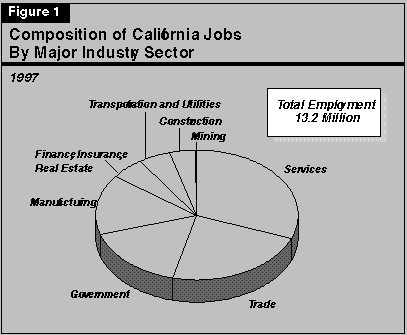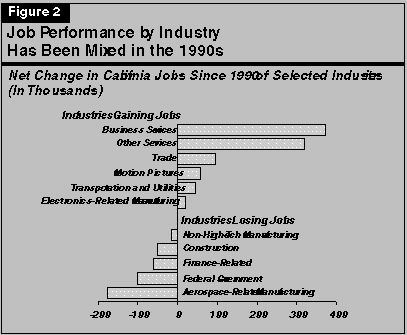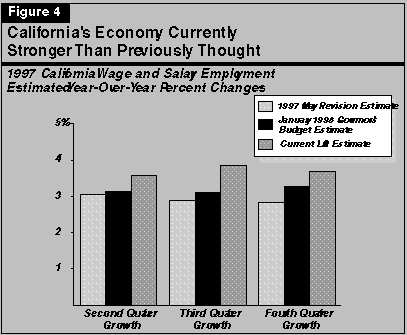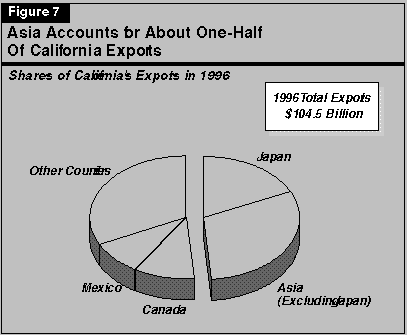
Economic and demographic developments are extremely important factors in California's budget outlook. For example, the strength of California's economy is the single most important determinant of the levels of collections from personal income taxes, sales and use taxes, and corporate income taxes. Similarly, California's population and economic trends affect spending in many of the state government's key program areas, including health and social services, education, and youth and adult corrections.
In the early 1990s, the downturn in California's economic performance contributed to major revenue reductions which led to substantial budgetary shortfalls. More recently, just the opposite has occurred--the state's economic recovery has resulted in healthy growth in General Fund revenues, which in turn has contributed to significant improvements in the state's fiscal condition. The Governor's proposed budget for 1998-99 assumes that continued, though moderating, economic growth will characterize California over the next 18 months.
In this part, we review recent economic and demographic developments, discuss the forecasts contained in the 1998-99 Governor's Budget, and provide our own perspective on California's economic and demographic outlook.
As shown in Figure 1, about one-third of the state's jobs are in the broadly defined services
sector, which includes such diverse industries as computer and software design, motion picture
production, hotel and travel services, engineering, business and professional services, landscape
design, and auto repair. About one-fourth of the workforce is in the trade sector, which includes
retailers, wholesalers, and import-export firms. An additional one-sixth each is in manufacturing
and government. The remainder of California's jobs are spread among the construction,
finance-related, transportation, utilities, and mining sectors.


It shows that most of the net increase in California employment in the 1990s has been in the state's services-related industries. Within the broadly defined services sector, many of the new jobs created have been computer-related positions in the business services subsector. Significant employment gains also have been experienced involving motion picture production, as well as in the "other services" category. The latter includes amusement and recreation, health services, engineering, biotechnology, and management consulting activities.
The nonservice industries showing significant employment increases include computer and electronics-related manufacturing, wholesale and retail trade, transportation, communications, and utilities.
The majority of job losses in the 1990s have been in aerospace manufacturing. This industry, which includes producers of aircraft, missiles and other navigation systems, has lost 177,000 jobs, or more than two-thirds of the aerospace manufacturing jobs that existed in 1990. Military base closures are primarily responsible for the 100,000 decline in federal government employment between 1990 and 1998. Consolidations of major California banks were responsible for the 60,000 job decline in the finance, insurance, and real estate industry subsector. Despite recent gains, construction employment also has experienced a net loss in employment in the 1990s. The 50,000 jobs lost in construction are due to declines in residential building activity during the decade (relative to levels in the 1980s).
Figure 3 summarizes the major features shaping California's near-term economic outlook.
| Figure 3 |
| Major Features Shaping California's Economic Outlook |
|
|
|
|
|
|
Job Growth Currently Strong. The recent performance of California's economy has been
stronger than was assumed in previous forecasts made last year. As indicated in Figure 4 (see
next page), wage and salary employment in the last three quarters of 1997 was up strongly from
the prior year. The updated increases shown in the figure are greater than assumed in both the
1997-98 Budget Act forecast, and the Governor's January 1998 budget economic forecast. These
upward employment-growth adjustments indicate that the California economy ended 1997, and is
beginning 1998, with considerable momentum.

Expansion Has Spread to All Regions and Industries. California's recent job growth has been broad-based, with major gains in services, construction, retail trade, and computer and electronics manufacturing. Regionally, continued job growth has occurred at a strong pace in the San Francisco Bay Area, and gains have accelerated in southern California--where growth had lagged in the earlier stages of the expansion.
Residential Construction Finally Rebounding. Permits for new construction in California during 1997 were up by 18 percent from the prior year, reflecting gains in virtually all regions of the state. Key indicators point toward further gains in home sales and construction in 1998. For example, home prices in California rebounded 10 percent in 1997, which is a sign of renewed confidence and activity in the state's real estate markets. As shown in Figure 5 (see next page), home price appreciation has been strongest in Santa Clara County, the San Francisco Bay Area, and Orange County. However, the gains are now extending to all regions of the state.

Interest Rates and Inflation Low. Despite the fact that the U.S. economy has been operating at near full capacity (reflected in part by a very low unemployment rate and reportedly tight labor markets), inflation has remained remarkably low. The U.S. Consumer Price Index (CPI) was up just 1.7 percent between December 1996 and December 1997, and other measures of inflation show similarly low increases. Although wages have started to rise in response to tightening labor markets, these increases have not yet been translated into higher product prices. In response to the positive news regarding inflation, U.S. long-term interest rates declined over the past year, with the yield on 30-year Treasury bonds falling to below 6 percent at year-end. These low interest rates will give an added boost to home construction in the state. Lower monthly mortgage payments resulting from the refinancings of existing mortgages also will add to consumer discretionary incomes in 1998, further bolstering consumption spending in the state.
In summary, California is entering 1998 with considerable momentum, with jobs and income expanding at a healthy pace. The greatest known threat at this time to this otherwise bright outlook relates to Asia's financial and related economic problems. Given the potential threat to California associated with Asia, we discuss below in more detail the topic of Asia's financial crisis, including its implications for California in 1998 and 1999.
Impacts on California--Negative on Balance. Figure 6 (see next page) summarizes the principal
ways in which Asia's problems could affect California.
| Figure 6 |
| How Asia's Problems
Could Affect California |
| Negative Factors |
| Possible Mitigating Factors |
As indicated in the figure, there are four main negative effects involved:
Mitigating Factors. In evaluating the net adverse impact of Asia's problems, it is also important to take into account mitigating factors which tend to reduce the net effect on California:

Asian-Related Problems Expected to Slow But Not Stall California's Expansion. Overall, we estimate that financial and economic problems in Asia will depress employment and income growth in California by between 0.5 percent and 1 percent per year in 1998 and 1999. However, as indicated above, the state is entering 1998 with considerable momentum, so even after accounting for the negative effects of Asia, the state should register moderate economic growth over the next two years. The "bottom line" is that, while Asia's problems do pose a risk to California, they are but one of several factors shaping the outlook for the next two years.
| Figure 8 | |||
| Summary of Department of Finance's Economic Outlook | |||
| Percent Changesa | |||
| Preliminary 1997 | Projected | ||
| 1998 | 1999 | ||
| United States Forecast | |||
| Percent change in: | |||
| Real GDP | 3.8% | 2.7% | 2.0% |
| Pretax corporate profits | 7.3 | 4.6 | -0.4 |
| Unemployment rate (%) | 4.9 | 4.7 | 4.9 |
| Federal funds interest rate (%) | 5.5 | 5.9 | 6.5 |
| California Forecast | |||
| Percent change in: | |||
| Personal income | 7.2% | 6.3% | 6.0% |
| Wage and salary jobs | 3.1 | 2.8 | 2.3 |
| Taxable sales | 5.9 | 4.8 | 4.3 |
| Consumer Price Index | 2.2 | 2.6 | 3.4 |
| Unemployment rate (%) | 6.3 | 5.6 | 5.4 |
| New housing permits (000) | 110 | 130 | 126 |
| aUnless otherwise indicated. | |||
Effect of Asia. The administration indicates that its forecast includes a slightly greater than
0.5 percent downward adjustment to the rate of growth in personal income in both 1998 and
1999 to reflect the net impact of the problems in Asia.